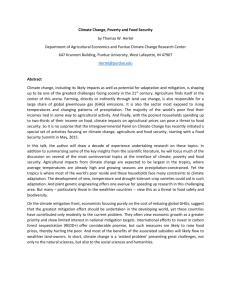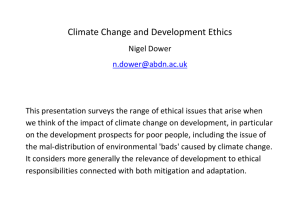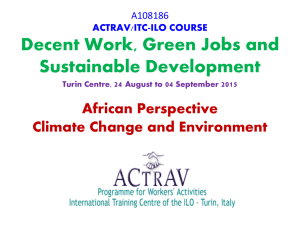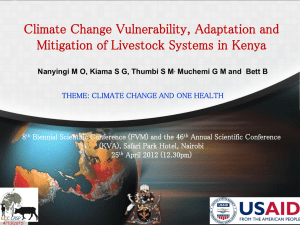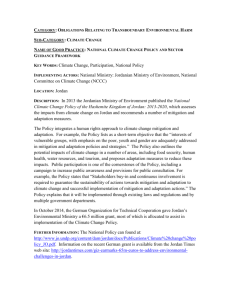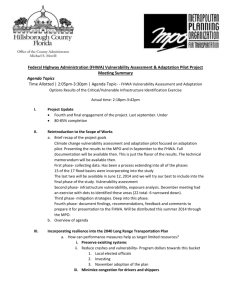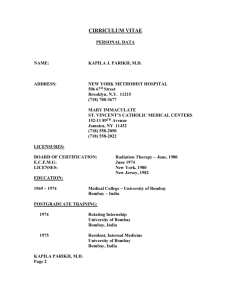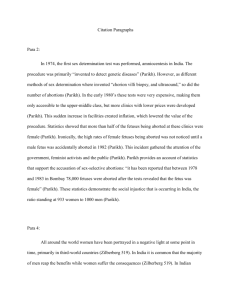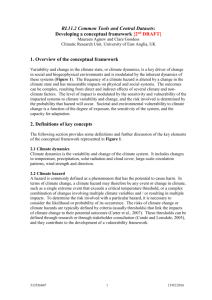Chapter 4
advertisement
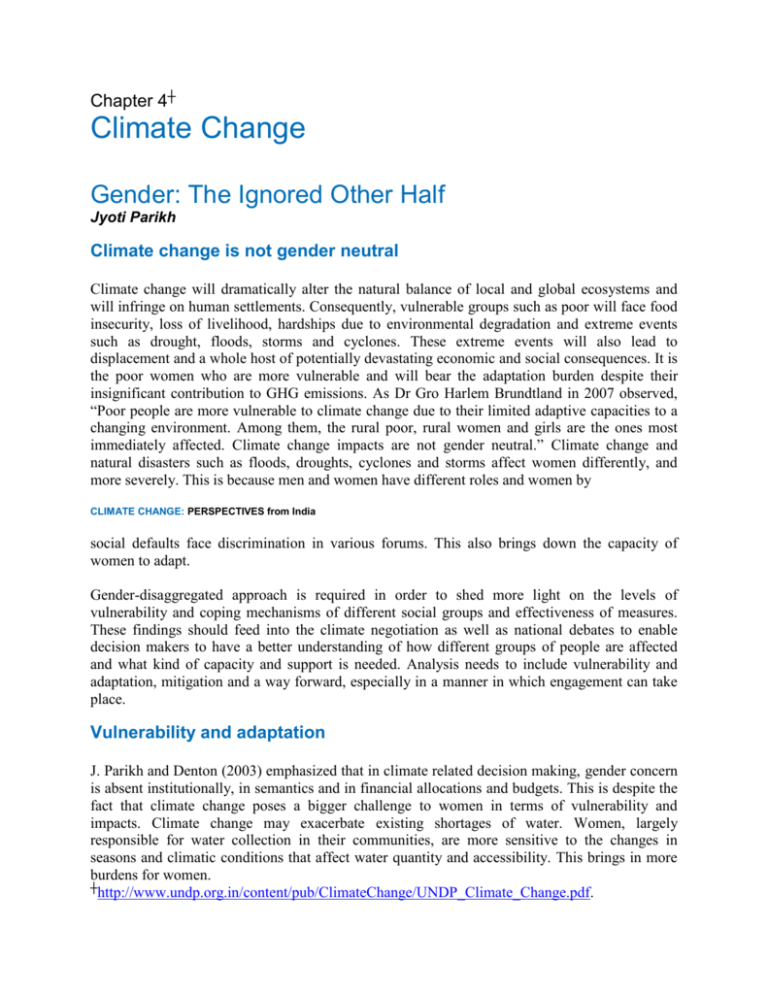
Chapter 4┼ Climate Change Gender: The Ignored Other Half Jyoti Parikh Climate change is not gender neutral Climate change will dramatically alter the natural balance of local and global ecosystems and will infringe on human settlements. Consequently, vulnerable groups such as poor will face food insecurity, loss of livelihood, hardships due to environmental degradation and extreme events such as drought, floods, storms and cyclones. These extreme events will also lead to displacement and a whole host of potentially devastating economic and social consequences. It is the poor women who are more vulnerable and will bear the adaptation burden despite their insignificant contribution to GHG emissions. As Dr Gro Harlem Brundtland in 2007 observed, “Poor people are more vulnerable to climate change due to their limited adaptive capacities to a changing environment. Among them, the rural poor, rural women and girls are the ones most immediately affected. Climate change impacts are not gender neutral.” Climate change and natural disasters such as floods, droughts, cyclones and storms affect women differently, and more severely. This is because men and women have different roles and women by CLIMATE CHANGE: PERSPECTIVES from India social defaults face discrimination in various forums. This also brings down the capacity of women to adapt. Gender-disaggregated approach is required in order to shed more light on the levels of vulnerability and coping mechanisms of different social groups and effectiveness of measures. These findings should feed into the climate negotiation as well as national debates to enable decision makers to have a better understanding of how different groups of people are affected and what kind of capacity and support is needed. Analysis needs to include vulnerability and adaptation, mitigation and a way forward, especially in a manner in which engagement can take place. Vulnerability and adaptation J. Parikh and Denton (2003) emphasized that in climate related decision making, gender concern is absent institutionally, in semantics and in financial allocations and budgets. This is despite the fact that climate change poses a bigger challenge to women in terms of vulnerability and impacts. Climate change may exacerbate existing shortages of water. Women, largely responsible for water collection in their communities, are more sensitive to the changes in seasons and climatic conditions that affect water quantity and accessibility. This brings in more burdens for women. ┼ http://www.undp.org.in/content/pub/ClimateChange/UNDP_Climate_Change.pdf. Climate change induced sea level rise affects the fishermen and fisherwomen not only in terms of fish-catch but also in term of water scarcity. Sea ingression turns local water bodies saline thus pushing women to search more for fresh water. Moreover, women face threat to their livelihoods as fishing may also be affected by sea level rise and intrusion of saline water into freshwater systems. Besides, large-scale migration from inundated areas is expected. Migration again leads to extra hardships for women. Due to extreme events and disasters, men migrate more often than women do. In dry land areas, the female-headed households left behind are often the poorest. To manage the house women put in significantly extra efforts. As climate change intensifies natural disasters, more women will be affected if proper measures are not taken. Women accounted for 55-70 percent of Banda Aceh tsunami deaths; 70 percent of the deaths during the 2003 European heat wave were women. Ulrike Rohr points out that when Bangladesh was hit by a devastating cyclone and flood in 1991, the death rate was reportedly five times higher among women. In disasters such as intense rainfalls, floods, cyclones and storms, women suffer more due to their restricted mobility, inability to swim or run, pressures from family and household responsibilities and less exposure to trainings and information such as early warning signals (See Table 1: Impacts on Gender: Poverty, Wellbeing and the MDGs). Table 1: Impacts on Gender: Poverty, Wellbeing and the MDGs Climate Change Forest Degradation of forests Food and Agriculture - Less yield from crops - Increased food prices - Change in food patterns - Depleting livestock Impacts on gender, livelihood, poverty, wellbeing and the MDGs - More drudgery for women for fuel and water - Less time for income generating activities - Less time for children education - Reduction of income and due to Non-timber forests Products (NTFPs)) - Loss of eco-tourism opportunities. - Reduced calories intake for women and girl children - Higher food insecurity for women - Less milk/nutrition for children, livelihood Water - Reduction in water availability - More dependence on unsafe water - Longer distances for fetching water - Impacts on mother and child nutrition Biodiversity - Loss of species (flora and fauna) - Loss of medicinal plants/herbs - Loss of mangroves and corals. - Loss of gene pool. - Loss of indigenous practices - Loss of livelihood - Reduced income - Increased vulnerability Health - Water borne diseases - Increase of diseases like dengue malaria, etc - Respiratory diseases due to indoor air - Women and children more , vulnerable - Infant mortality - Disease sensitivity pollution and other emissions Gender involvement in mitigation It is estimated that $125 billion was invested on renewable energy technology in 2006 to address climate change. Involving women in such initiatives will make this investment effective. Engaging in income- earning activities that are climate compatible could be the way to ensure that women can afford to purchase labour – saving energy technologies for their household chores (WED O, 2004) and thus contribute towards mitigating climate change. Women have proven themselves capable of operating and also constructing renewable energy applications on their own, when provided with appropriate training and support. Efficient fuels and technologies will penetrate only if the income generated from women’s time saved exceeds the cost of the fuels and technologies. Urban women’s role can be significant to implement energy efficiency programmes at the household level dealing with lighting, heating and cooling appliances while rural women are already playing crucial roles in using biomass, biogas and solar devices. Capacity building and information campaigns can result in substantial gains. J. Parikh (2002) highlighted the possible role of women in Clean Development Mechanism (CDM) as women are engaged in a number of activities such as brick making, charcoal making, waste management, afforestation and reforestation and energy projects such as biofuels production. In this energy efficiency can lead to CO2 mitigation. CDM, through carbon sequestration from afforestation and reforestation, can also be done by poor rural women. Women’s role in recycling and waste management within the households includes a variety of opportunities to make women an important agent in resource conservation. Moreover, rag-picking women serve useful purpose and reduce municipality budget for garbage collection. In Mexico poor women have set up a profitable recycling company using municipal solid wastes. Also women in rural areas can source gas from local wastes. Women should participate in all dialogue on the generation of solutions for disaster risk management and conflict prevention Adaptation Strategies Capacity development can strengthen resilience to climate change by strengthening the capacity of national and local institutions. Poverty reduction mechanisms can also strengthen linkages between climate change risk management and poverty reduction by mainstreaming this into poverty reduction strategy and assistance to developing countries can help them to choose the right energy paths that provide low carbon sources of power (Lorena Aguilar, 2009). Mainstreaming climate change into environment and energy services and crisis prevention and recovery work is needed to support mitigation and adaptation action on the global, regional, national and provincial and community levels. Some of the strategies are: pursuing policy and agenda setting, experience-sharing and training activities, establishing a system of experts to assist countries to access, integrate and sequence different sources of financing and it will evaluate alternative mitigation and adaptation options. It needs focus on policy change and institutional strengthening through activities such as training for policy makers and national assessments of policy options and also on market development and transformation for lower carbon technologies and sustainable land management. Gender inclusion and change mitigation may need to support policy for climate change mitigation and adaptation (WED O, 2007). At the community level we need to focus on gender related activities such as increasing access to sustainable sources of energy and water in rural areas and developing the capacities of communities to make their livelihoods more resilient in the face of climate change. Women should participate in all dialogue on the generation of solutions for disaster risk management and conflict prevention. National capacities need to be strengthened for crisis-related gender analysis including the incorporation of gender statistics into assessments of disaster risks, impacts and needs. International Action International efforts are needed for policy negotiations on how to integrate gender in the climate change mechanisms. International treaties like the United Nations Framework Convention for Climate Change, Kyoto Protocol, CDM and Marakesh Accords have impact on women. The Inter-governmental Panel on Climate Change (IPCC) also has a role in assessing latest scientific, technical and socio-economic literature produced worldwide relevant to the understanding of the risk of human induced climate change and its observed and projected impacts and options for women. Conclusion Strategies must be evolved for long-, medium- and short-term policies needed for substantial involvement of women not only in terms of beneficiaries but also in their say in decision making. Climate change strategy needs to focus on supporting design of policies and action plans, promoting early adaptation as well as long-term strategies like directing investment towards low carbon technologies and practices and finally integrating climate change broadly into development assistance at the global, regional and national levels. The nexus between climate change and gender equality needs to be intensified so that the capacity of the national and local institutions can be strengthened in terms of resilience to climate change by involving wide range of stakeholders. Prime Minister’s Climate Change Council has proposed eight missions that cover areas such as agriculture, water, forests, sustainable habitat, solar energy and energy efficiency and strategic knowledge. These missions need to integrate greater concerns for gender- inclusive agenda. References: H.E. Mrs. Gro Harlem Brundtalnd, ‘Keynote Address: Levers of global security: examining how a changing climate impacts women’, 2007 IPCC, ‘Fourth Assessment Report – Synthesis Report’, WMO and UNE P, 2007 J. Parikh, ‘Gender and Climate change: Framework for Analysis, Policy and Action’, www.undp.org., 2008 J. Parikh and Denton F., ‘Gender and climate exchange’, Tiempo 47, March 2003. J.Parikh and F. Denton, ‘Gender and Climate Change: Vulnerability, Adaptation, Mitigation and Financial Mechanisms: Proceedings and Thematic Paper Prepared for COP8’, 2002. Lorena Aguilar, ‘Women and Climate Change: Vulnerabilities and Adaptation, State of the World 2009’, World Watch Institute, Washington DC, 2009 WED O, ‘Changing the climate change: Why women’s perspectives matter?’, http://w w w.wedo.org/files/climate change orange2ebook.pdf., 2007


